Do you know you should not be throwing away the pulp from a juicer? If you did before now, good for you. If you did not, you are about to learn some new ideas.
Juice is consumed by a large proportion of the world’s population which also makes juicers one of the popular kitchen appliances.
If you prefer homemade juice, get ready to invest in more containers and freezer bags because you’ll be saving a lot of pulp.
Is the pulp from a juicer of any use? What better use is pulp other than dumping it in the trash can? Is it safe to reuse them? These are important questions that will be answered after reading this article.
What is pulp from a juicer?
The stringy byproduct left over after juicing fresh fruits and vegetables is known as pulp. Pomace is the technical term for it.
What to do with the pulp from a juicer
1. Quiche

Whip a few veggie pulps into your egg mixture to add extra nutrients and vitamins to your quiche. Bake with ham and cheese on top for extra savory goodness.
2. Cereals

Fruit pulp can be dehydrated and sprinkled on your favorite cereal. Mix the new puree into your oats or buckwheat for a vitamin boost in the morning.
Add some nuts, bananas, or shredded coconut to make a nutritious breakfast to get you through the morning.
3. Meatballs

Adding vegetable pulp to meatballs, burgers, or meatloaf gives them a fresh flavor boost, even if it’s not the most conventional of recipes.
4. Pulp dip

If you’re making a simple homemade hummus with chickpeas, tahini, olive oil, and basil in the food processor, throw in some leftover pulp as well.
Mix the pulp with cream cheese, Greek yogurt, or butter to make a nutrient-dense spread for bagels, crackers, and bread.
5. Pulp soup broth

This homemade broth can be used to make any of your favorite soups and stews. All you need is vegetable pulp, water, salt, pepper, and your favorite spices.
6. Popsicles

Make a big batch of your preferred juice and freeze some of it. Fill some of the masticating pulp into your popsicle molds and fill the molds halfway with juice.
Make sure you freeze the popsicles before eating.
7. Vegan basil pesto

Combine leftover pulp from cold-pressed almond milk, fresh basil, pine nuts, and garlic, as well as a squeeze of lemon juice for acidity and brightness to make vegan basil pesto.
8. Raw pulp crackers

For those with food allergies or intolerance or those who want a healthy snack, pulp crackers are a great grab-and-go choice.
Any vegetable pulp will work, but carrot pulp is a good choice.
9. Add to baked goods

More moisture and fiber could be added to quick bread, cakes, muffins, and even cookies with pulps.
Pulp from sweeter, fruitier, and juicier foods such as apples, citrus, beets, carrots, melon, and grapes best does.
10. Make a veggie broth

You can easily turn your juicing pulp into a savory, flavorful vegetable broth if it contains vegetables like celery, carrots, onion, or garlic.
In a big saucepan with olive oil, cook the pulp till it starts to boil, then add your preferred spices, fresh basil, and a few glasses of water.
Lower the heat and continue to cook for another 2 hours. Before straining, detach the pan from the heat and tuck it away to cool.
11. Smoothie thickener

Add pulp from fruits and vegetables to thicken your smoothies and make them creamier.
You’ll not only improve the flavor, but you’ll also add some overall healthier nutrients to the mashup that will keep you fuller for longer. It is a good choice for protein smoothies.
12. Make “pulp sicles”

The method is as clever as the name. Simply combine your leftover pulp with a little juice and pour it into popsicle molds or an ice tray. Insert a wooden stick into the center and freeze for at least 4 hours, or until completely solid.
13. As fritters

The pulp of celery, beet, carrot, spinach, or cucumber adds an earthy flavor to the burgers and helps them hold their shape. They also supply a plethora of nutrients to your vegetarian meal.
14. Smoothies

Incorporating residual pulp into protein shakes will add extra nutrients and fiber. The pulp will also plump up your smoothie, making it more like a milkshake.
15. Fruit leather

Fruit leather is a delicious snack that you can make even with pulp. Squeeze and specify the fruit pulp evenly to allow it to dry evenly.
Put in a drier for 12-14 hours or bake at 115 degrees in your oven on the lowest setting. If the fruit isn’t sweet enough on its own, add lemon juice and sugar for a slimmer texture and sweeter flavor.
16. Clothing dye

It’s fascinating to discover that offcuts pulp can be used to color clothing. Nori Co, the founder of Sunshine Juice in Tokyo, Japan, worked with a botany lab to generate green dye from leftover natural juice pulp.
Afterward, they generated their clothing brand by dyeing 100% organic cotton tees.
17. Make granola bars or energy balls

Mix about a cup of the leftover pulp for every three cups of oats you’re baking to get more nutrients and energy. This snack is high in vitamins and minerals your body will appreciate.
18. Cream cheese spread

It’s easy to make a cream cheese spread with your juice pulp. This complements crackers, sandwiches, vegetables, and other foods well.
You’ll need approximately 12 cups of fruit or vegetable pulp. Combine the pulp with about a cup of cream cheese. You can beat the cream cheese lightly by hand or with your stirrer.
19. Muffins and bread

For muffin and bread recipes, juice pulp is a great source of nutrient-dense moisture. Combine berries, oranges, apples, carrots, and even kale to create your flavor combination.
20. Tea

To make a delicious, aromatic tea, dehydrate your fruit pulp and add some flower varieties, vanilla, cinnamon, cardamom, or citrus bergamia. In one cup, you’ll get both flavor and valuable phytonutrients.
21. Breadcrumbs

Bread, dried vegetables, and fruit pulp may be used to top salads or as a substitute for breadcrumbs in conventional baked goods such as fillings (use veggie pulp) or pastry porridge (use fruit pulp).
22. Dipping sauce

Mix the vegetable pulp with sour cream and spices to make a fantastic veggie or chip dip. Think about making chutneys or incorporating them into homemade hummus for an extra kick.
23. Make dog treats

Make homemade crackers or integrate them into your dog meals. Best be assured that your dog would love you more.
24. Fertilizer

Fresh juice pulp mulched into the soil all over your trees and plants acts as a superb fertilizer. It also helps encourage fungal growth and feeds soil-enriching worms.
25. Compost

Your compost will receive help from the addition of fresh pulp. It will boost your garden by adding vital nutrients to the soil and encouraging healthy mycorrhizal growth.
Just keep in mind not to leave the pulp inside the house. Stir it into compost to prevent bugs and pest infestation and to aid decomposition.
Can you freeze leftover pulp?
Yes, you can. Keep your pulp for about a day in an airtight jar or sealed in a resealable baggie.
However, use it as soon as possible to reap the greatest benefits. It can also be frozen in baggies, but remember that freezing destroys some nutrients, lowering the nutritional value.
Can you eat leftover pulp from the juicer?
Absolutely. However, most centrifugal juicers have enough flaws to leave some nutrients in the pulp. Apart from that, it’s quite tasty and not worth losing.
Is the pulp from the juicer good for you?
Yes, it is. Juicing is a quick and easy way to include more fruits and vegetables in your diet. All the strength is found in the juice pulp, while most of the vitamins and minerals are found in the juice itself.
Are pulp juicer leftovers still good?
Yes, they are. When you add the leftover pulp to any type of food or drink, it activates more nutrients in that food.
Furthermore, you should not be concerned about salvaging your pulp because it is simple to store if frozen or kept in the refrigerator.
FAQs
How long can you keep pulp from your juicer?
If you’re not going to use your pulp right away, store it in the fridge for up to 24 hours in a sealed container. It can also be frozen in bags, though the color and texture may differ marginally when defrosted.
What do you do with the pulp from a blender?
Crushed and pulverize the pulp into liquid in a blender. Use this liquid to thicken smoothies. The mush could also be used to add more vitamins or as a flavor enhancer. Soups blended in a blender are the same way.
Is juicing worth it?
Yes, it is. However, it isn’t any better for you than eating whole fruits and vegetables.
Juicing is the process of extracting juice from fresh fruits and vegetables. Most of the vitamins, minerals, and plant chemicals (phytonutrients) found in the fruit are in the liquid.
How do you strain juice after juicing?
To make it easier to pour, keep the juice you want to strain in a pitcher or a glass. Slowly and carefully pour the juice into the strainer so it does not overflow. Allow the liquid to drain completely through the strainer before adding more.
Conclusion
If you knew the amazing things you could do with the pulp from your juicer, you’ll call it a blessing in disguise.
If you read this article to the end, you’ll agree that pulp can come in very handy and you’ve probably been wasting valuable nutrients.
However, you must use the pulp within 24 hours of juicing or freeze it to avoid it going bad and becoming useless.
If you love to drink fresh orange juice, see how you can get all the juice out of your oranges.
Thanks for reading.
